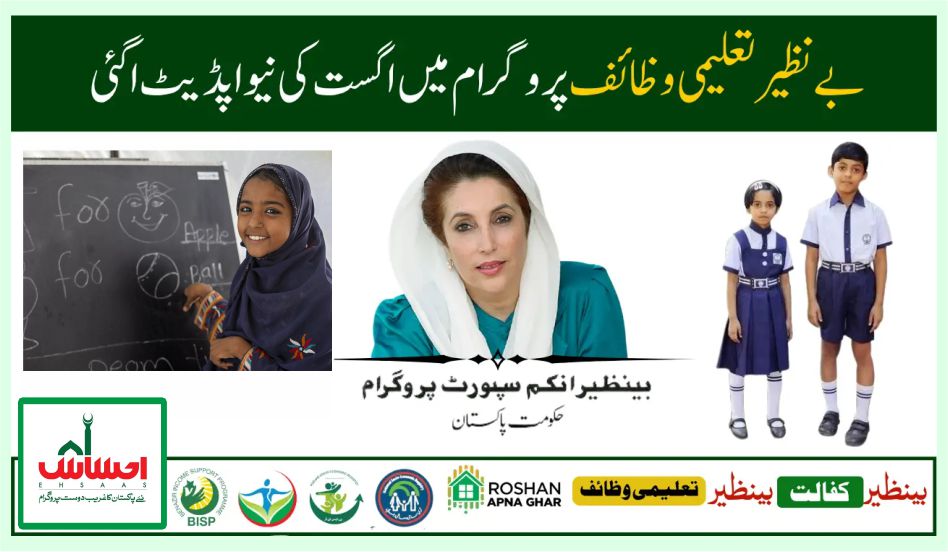Contents
- 1 Benazir Taleemi Wazaif Programme 2025
- 1.1 Stakeholders Involved
- 1.2 Background and Expansion
- 1.3 Key Processes
- 1.4 Eligibility Criteria
- 1.5 Enrollment Process
- 1.6 Co-responsibilities of Beneficiaries
- 1.7 Benefit Amounts
- 1.8 Graduation Bonus for Girls
- 1.9 Enrollment Statistics
- 1.10 Disbursement of Funds
- 1.11 What is Benazir Taleemi Wazaif?
- 1.12 Types of Support
- 1.13 Payment Update for August 2025
- 1.14 Payment Channels
- 1.15 Notification Methods
- 1.16 Eligibility for August 2025 Payment
- 1.17 How to Check Eligibility and Payment Status
- 1.18 What If Payment Is Not Received?
- 1.19 Tips for Smooth Payments
- 1.20 BTW and Academic Empowerment
Benazir Taleemi Wazaif Programme 2025
The Benazir Taleemi Wazaif Programme 2025 is a significant initiative under the Benazir Income Support Programme (BISP) aimed at promoting education across Pakistan. It focuses on creating awareness among BISP beneficiary families about the importance of primary, secondary, and higher secondary education. The programme’s main goal is to increase the enrolment of children in schools, improve their attendance rates, and decrease dropout rates. By doing so, it ensures that children not only start school but also continue their education, leading to long-term sustainable benefits for themselves, their families, and the country.
Stakeholders Involved
A successful programme requires the cooperation of various stakeholders. The key participants in this initiative include the BISP itself, Provincial Education Departments, individual schools, and generous donors who provide financial support. Each of these groups plays a vital role in making sure children get access to education and stay enrolled throughout the academic years. Provincial Education Departments work on ground-level implementation, schools ensure enrolment and attendance monitoring, and donors provide much-needed funding to sustain the programme’s wide reach.

Background and Expansion
The Benazir Taleemi Wazaif Programme was first piloted in November 2012 in five districts. Due to its success, it was expanded in phases: to thirty-two districts by 2015, then fifty districts by 2018, and ultimately reached one hundred districts in January 2020. By July 2020, it was available across all districts of Pakistan, making it a nationwide effort. This gradual scaling allowed the programme to address challenges, improve processes, and widen its impact on children’s education.
Key Processes
One of the critical steps to ensure the programme’s success is the Micro Supply Capacity Assessment (MSCA). This detailed assessment gathers data from public and private schools through provincial education departments. The MSCA evaluates each school’s capacity, including student enrolment numbers, infrastructural conditions, accessibility, and the geographical catchment area. This information helps identify gaps in educational infrastructure and ensures resources are directed where needed most.
Another important component is Social Mobilization, where specially trained field teams visit different districts and localities to raise awareness among families about the benefits of education and the stipends offered through the programme. These teams encourage parents to register their children, especially those who have not yet complied. Families are regularly visited to ensure children attend school, and problems are addressed promptly to avoid dropouts.
The programme also runs a Public Information Campaign (PIC) using media to reach a broader audience, increasing awareness about education and stipend eligibility. To facilitate enrolment, registration camps are held at tehsil offices and other centers.
The programme strictly monitors Admission and Attendance Compliance. Children must meet attendance criteria to qualify for cash transfers. If attendance requirements are not met for three consecutive quarters, payments are suspended. This approach reinforces the importance of regular school attendance.
A Case Management System handles complaints from beneficiaries efficiently, ensuring timely resolution and maintaining confidence in the programme.
BISP Kafalat Biometric and CNIC Problems Solution 2025
Eligibility Criteria
To be eligible for the stipend, a child must belong to a family actively registered under the BISP Kafalat scheme. The programme supports children in three education levels with specific age ranges:
- Primary Education: Ages 4 to 12
- Secondary Education: Ages 8 to 18
- Higher Secondary Education: Ages 13 to 22
These age groups ensure that children receive support appropriate to their schooling stage.
Enrollment Process
Enrollment involves admitting the child to a school or college within any district covered by the programme. Beneficiaries must visit designated enrollment camps or field offices with their CNIC, B-form/CRC verified by NADRA, and an admission slip that details the child’s class and school or college, verified by a teacher. Verification by NADRA is mandatory to maintain accuracy and prevent fraud.
Co-responsibilities of Beneficiaries
The programme sets two main responsibilities for beneficiaries to maintain their eligibility for stipends:
-
Admission Co-responsibility: The child must be admitted to the school or college, and the admission must be verified during registration.
-
Attendance Co-responsibility: The child must attend at least 70% of the effective school or college days each quarter. Payments begin from the second quarter onward once attendance compliance is verified.
Benefit Amounts
The stipend amounts vary based on the education level and gender to encourage girls’ participation:
- Primary Level: Rs. 1,500 per boy, Rs. 2,000 per girl per quarter
- Secondary Level: Rs. 2,500 per boy, Rs. 3,000 per girl per quarter
- Higher Secondary Level: Rs. 3,500 per boy, Rs. 4,000 per girl per quarter
Graduation Bonus for Girls
To promote girls’ education, those who complete primary education receive a one-time graduation bonus of Rs. 3,000. This incentive encourages families to support girls’ continued education beyond the primary level.
BISP 8171 July 2025 Double Payment Who Will Receive Rs 27000 This Time?
Enrollment Statistics
Since its inception, over 12.01 million children have enrolled under the programme across education levels, with the following distribution:
- Primary: 4,853,113 boys and 4,453,211 girls
- Secondary: 1,323,955 boys and 1,082,904 girls
- Higher Secondary: 156,851 boys and 140,810 girls
These numbers demonstrate the programme’s extensive reach and its success in promoting education nationwide.
Disbursement of Funds
To date, BISP has disbursed over Rs. 63.34 billion through the Benazir Taleemi Wazaif Programme. The disbursements have increased annually, reflecting the growing number of beneficiaries and the government’s commitment to supporting education. Payments are typically made quarterly and are carefully monitored to ensure they reach the intended recipients.
What is Benazir Taleemi Wazaif?
Benazir Taleemi Wazaif (BTW) is a national education stipend program designed to help children from low-income families by providing financial support for their schooling. It is part of the broader BISP framework, which aims to empower disadvantaged families.
The programme encourages school attendance and reduces dropouts by offering monthly stipends and scholarships for students from primary through higher secondary levels. It supports both boys and girls enrolled in public and selected private schools.
Types of Support
- Scholarship for Secondary Education: Financial aid for grades 9 to 12 students to encourage continued schooling.
- Stipend for Elementary Education: Monthly payments for primary school children.
- Special Merit Supplements: Additional financial rewards for students who perform well academically.
Payment Update for August 2025
Payments are generally released between the 10th and 20th of each month. For August 2025, payments are expected around August 18-19, following extensive system testing. Recipients should monitor official BISP and NADRA announcements via SMS and mobile apps to stay updated.
Payment Channels
Recipients can receive stipends through:
- HBL Mobile Account linked to their phone number
- BISP Esahulat Franchisees (local agents)
- Designated Bank Branches for bank-linked accounts
Beneficiaries should confirm their preferred payment method before the disbursement date via the BISP portal or their nearest franchise.
Notification Methods
BISP keeps beneficiaries informed through:
- SMS alerts confirming payment release
- Notifications on the BISP mobile app
- Updates from local Esahulat franchisees
Regularly checking these channels from August 15-20 helps confirm payment status.
Eligibility for August 2025 Payment
To qualify, beneficiaries must:
- Be actively registered in the BISP Taleemi Wazaif database.
- Maintain at least 70% attendance for July 2025, verified by their school and submitted to NADRA/BISP.
- Provide valid identification documents such as CNIC or B-form and proof of enrollment.
- Not receive other conflicting educational benefits that could disqualify them.
How to Check Eligibility and Payment Status
- Online: Visit the official BISP website and check the Taleemi Wazaif section.
- SMS: Send your CNIC number to the BISP helpline (e.g., 8171) for payment status.
- Franchisee: Visit local BISP agents with your CNIC/B-form.
- School: Some schools can verify attendance and academic records directly.
What If Payment Is Not Received?
Common reasons for delays or rejection include:
- Attendance below 70%
- Missing or incorrect documentation
- Payment mode issues (expired SIM card, incorrect bank details)
- Delayed school reporting
To resolve these:
- Confirm attendance is submitted on time.
- Update your payment channel via Esahulat agents or banks.
- File complaints through BISP helpline or portal.
- Visit BISP regional offices if needed.
Tips for Smooth Payments
- Keep your NIC-linked SIM active and topped up.
- Maintain attendance above 75% as a buffer.
- Ensure school data is accurate and timely.
- Verify school submits attendance monthly.
- Follow official BISP communications, ignoring spam messages.
BTW and Academic Empowerment
The Benazir Taleemi Wazaif Programme goes beyond financial help. It empowers students and communities by:
- Reducing the financial burden of schooling, including supplies and transport.
- Encouraging higher enrolment, especially for girls.
- Improving student performance through regular attendance incentives.
- Supporting social and economic development via increased literacy.
